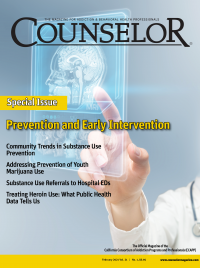Share

Prevention works! However, prevention’s only proof of value is when the data shows change is moving in the right direction. The strategic prevention framework (SPF) used in prevention practice offers a map to a systemic, data-driven process for community-level change. We may feel that it is working, but it does not matter how well the program, practice, or policy is received if there is no way to examine whether or not there is a positive effect within the community.
Overall, the SPF process requires multiple steps, including:
- Mining data at the local level
- Building capacity to provide for needed change in the data set
- Developing a plan to reach the intended audiences with appropriate efforts
- Implementing evidence-based practices that reach the focus population
- Evaluating the efforts to be sure that the intended outcomes met
Sustainability and cultural competence are part of the process throughout. This is not an overnight process and the process is circular, not linear. There may be times when assessing, capacity building, data, and planning will need to be revisited.
Having been a school counselor and now a prevention specialist, it took me a long time to grasp the differences in data mindsets. Success, as a counselor, came by watching clients maneuver through whatever barriers they were facing. We counted our data in low-numbered digits, person by person. In prevention, the numbers are vast—too many to count. Primary prevention focuses on the vast number of people who never misused substances. Prevention efforts focus on relapse and treatment. The populations are huge and most people do not even realize they are our participants. Success does not come from watching people process through issues, but from watching data sets turn in the right direction.
For example, on a quantitative level, research indicates that there is a gap in the normative perception of thirty-day use of alcohol among middle and high school students. In Indiana, among those who completed the 2018 Indiana Youth Survey, 16.8 percent stated they had used alcohol in the previous thirty days. The perception of alcohol use among fellow students for the same previous thirty days was 67.1 percent (Institute for Research on Addictive Behavior, 2018).
This gap in perception shrinks considerably when the youth get to college. The same data show a smaller differential between use and perception of use. Unfortunately, the change is in the wrong direction. The results of the Indiana College Substance Use Survey 2019 (ICSUS) showed 60.8 percent of college students drank alcohol (King & Jun, 2019) and the perception is that 70 percent or more drink alcohol.
The perception of alcohol use in the teen years as normed behavior prevails. On a qualitative level, I was at a community meeting recently and the guest speaker asked a question that seemed simple, but disturbed me. The question was given to a group of middle-aged agency representatives. “How many of you had your first taste of alcohol in high school?” she asked, and not one person stood to say they had practiced abstinence in their teen years.
Data is compiled into three main components, broken down by effects and capacity to see change. While we know that change first happens at the cognitive level, it is often not considered an issue until it reaches a much bigger place. The aforementioned data is built on two of three categories: determinants (i.e., perception) and behavior. Perception of use is a determinant or predisposition of use—“use” being the behavior, according to the Theory of Normative Social Behavior (Padon, Rimal, Jernigan, Siegel, & DeJong, 2016). Consequences, or how the behavior directly effects the community, is the third category and can include death rates, employment statistics, legal issues, tax levels, or other structures that would affect people outside of the specific issue. These three levels often help us to define the length of time for the data to show results. Under normal circumstances, determinants will be the first to see change, behavior data will change next, followed by consequential change. The entire process typically takes three to five years to show proof at the consequential level.
From here we build the capacity of our prevention teams to meet the issue. We know the effort should be at the youth level. To build capacity to make change in the data, recruitment must be purposeful—these youths must be key influencers and capable of reaching the correct links to the youth population. While our agencies may be capable of reaching the focus population, none of us work in a vacuum. Real change requires a collaborative effort by all sectors of the community: schools, law enforcement, the faith community, parents, youth, health care, and treatment and recovery. In the end, we are all prevention advocates!
References
- Institute for Research on Addictive Behavior. (2018). Indiana youth survey. Retrieved from https://inys.indiana.edu/docs/survey/indianaYouthSurvey_2018.pdf
- King, R., & Jun, M. (2019). Results of the Indiana college substance use survey 2019. Retrieved from https://iprc.iu.edu/publications/icsus/ICSUS_Survey_2019.pdf
- Padon, A. A., Rimal, R. N., Jernigan, D., Siegel, M., & DeJong, W. (2016). Tapping into motivations for drinking among youth: Normative beliefs about alcohol use among underage drinkers in the United States. Journal of Health Communication, 21(10), 1079–87.

Katharine Sadler, MEd, CPS
Katharine Sadler, MEd, CPS, is a community prevention specialist who has worked as a teacher, school counselor, business executive in graphics and marketing, community activist, and grant evaluator. She has been with Prevention Insights at Indiana University (IU) Bloomington since 2007 and is also an adjunct instructor for the School of Public Health at IU. Her book, What Adults Need to Know About Kids and Substance Use, Dealing With Alcohol, Tobacco, and Other Drugs, was published by Search Institute in May 2011 and is on Library Journal’s 2012 best-seller list.








 Counselor Magazine is the official publication of the California Association of Addiction Programs and Professionals (CCAPP). Counselor offers online continuing education, article archives, subscription deals, and article submission guidelines. It has been serving the addiction field for more than thirty years.
Counselor Magazine is the official publication of the California Association of Addiction Programs and Professionals (CCAPP). Counselor offers online continuing education, article archives, subscription deals, and article submission guidelines. It has been serving the addiction field for more than thirty years.